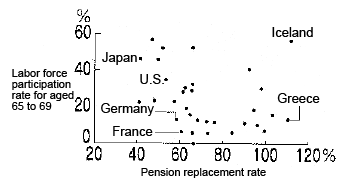Working becomes difficult as people grow older and lose physical strength. So, when an elderly worker has saved enough money, reaches the pension eligibility age, and feels financially secure, he/she decides to retire. As such, the labor force participation rate of the elderly tends to decline gradually as they age in any country.
Japan is known for its high labor force participation rate of the elderly. According to the Organisation for Economic Co-operation and Development (OECD) data, the rate for males aged 65 to 69 in 2011 varied considerably between countries, with Japan's rate at 46.2% far surpassing 6.2% in France, 12.9% in Germany, 23.3% in the United Kingdom, and 34.8% in the United States.
One reason behind Japan's high rate is that pension benefits are lower than in other developed countries. Thus, many elderly people in Japan choose to continue working for financial reasons.
The pension replacement rate is an indicator representing the ratio of the pension payout level of pensioners to the average income level of the working population. According to OECD figures for 2011, Japan's replacement rate (taking into account taxes on pension income and insurance premium payment) was just 41.4%.
As the graph shows, in the countries where the pension replacement rate is high, the labor force participation rate for males aged 65 to 69 tends to be high as well. It seems that the low replacement rate is the reason behind Japan's high labor force participation rate. In fact, a survey statistic in the government's "White Paper on the National Lifestyle Fiscal Year 2006" shows that 65% of the elderly cited financial reasons for continuing to work.
It is a generally observed fact that, wages being equal, people tend to stop working when they feel financially secure, regardless of gender or age. It seems this applies to elderly people, too.

* Translated by RIETI from the original Japanese "Yasashii Keizaigaku" column in the October 25, 2013 issue of Nihon Keizai Shimbun.


